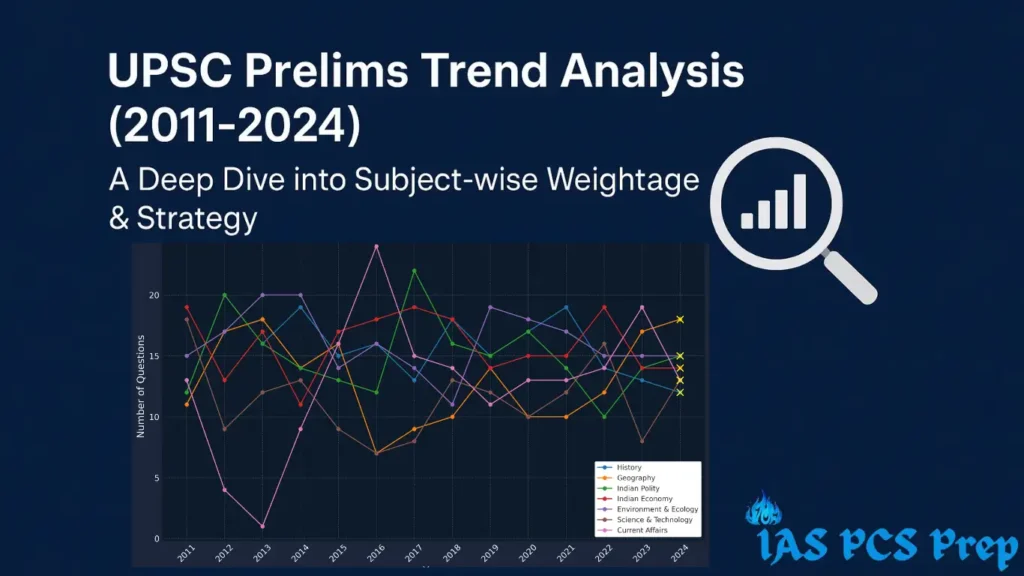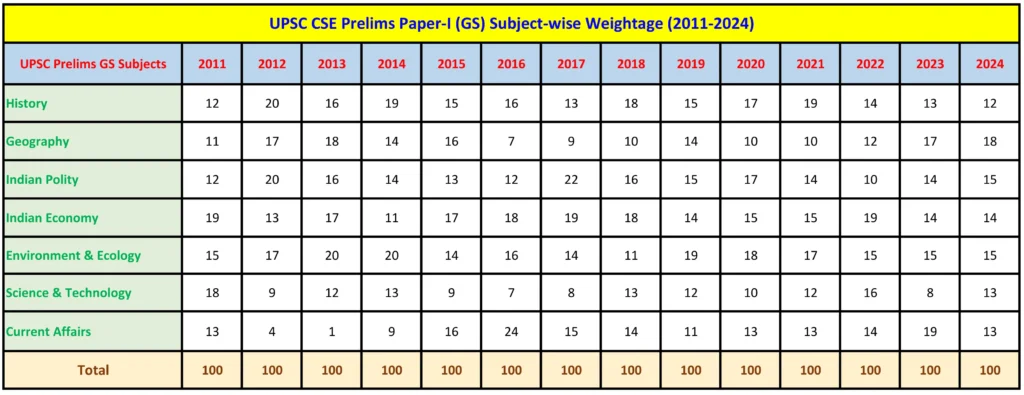UPSC CSE Prelims Trend Analysis (2011-2024): The Unofficial Rulebook for a Winning Strategy

Every year, lakhs of aspirants enter the battlefield of the UPSC Prelims. They carry the weight of countless books and endless hours of hard work. Yet, only a fraction emerge victorious. Why? Because they treat it like a college exam. It’s not. The UPSC Prelims is a strategic mind game, a complex maze with unwritten rules. To win, you must stop studying like a student and start thinking like a strategist.
This is not just another trend analysis. This is a forensic deep-dive, a 14-year autopsy of every official Prelims paper from 2011 to 2024. We will decode the signals UPSC has been sending, understand their core philosophy, and build a definitive, actionable blueprint for your success in the upcoming exams.
GS Paper-I: Managing Your Subject Portfolio Like a Pro-Investor
Think of the GS subjects not as a syllabus list, but as an investment portfolio. Some are stable, “blue-chip” stocks that guarantee returns. Others are high-growth equities that can multiply your score. And some are volatile assets that you must manage with caution. Your success depends on your asset allocation strategy.

Trend 1: The “Bedrock Assets” – Your Unshakeable Foundation
These are your blue-chip stocks. In the unpredictable sea of UPSC, they are the lighthouses that will guide you safely to shore.
- What the Data Says: Indian Polity (15 Questions in 2024) and Indian Economy (14 Questions in 2024) have remained remarkably consistent. For 14 years, they have been the most reliable and predictable part of the GS paper.
- The “Why”: These subjects form the very core of a nation’s governance and administration. A deep understanding of the constitution, political system, and economic framework is a non-negotiable requirement for a future civil servant.
- Your Investment Strategy: Aim for 90%+ accuracy here. This is non-negotiable. Move beyond just memorizing articles from Laxmikanth or facts from Ramesh Singh. Your focus must be on deep conceptual clarity. Understand the ‘philosophy’ behind Supreme Court judgments (Polity) and the ‘implications’ of the Union Budget (Economy).
Trend 2: The “High-Growth Stocks” – The New Kings of Prelims
These are the subjects that have shown explosive growth and now dominate the paper. Investing heavily here will boost your rank.
- What the Data Says: This is the most significant trend. Environment & Ecology (15 Questions) has cemented its place as a super-core subject. More dramatically, Geography (18 Questions), after a long slump, made a roaring comeback in 2024. Together, this “Green Duo” accounted for a staggering 33 questions—one-third of the entire paper!
- The “Why”: The real-world importance of climate change and sustainable development, combined with the structural integration of the Indian Forest Service (IFoS) exam, has made these topics critically important.
- Your Investment Strategy: Treat this “Green Duo” as your new Tier-1 priority. Your study must be integrated. Don’t just read about National Parks (Environment); locate them on a map (Geography). Don’t just learn about monsoon patterns (Geography); understand climate change’s impact on them (Environment). This integrated, application-based approach is what UPSC is now testing.
Trend 3: The “Volatile Equities” – The Risk You Must Manage
This is where UPSC plays its mind games and keeps you guessing. The numbers here are wildly unpredictable.
- What the Data Says: History (12), Science & Tech (13), and Current Affairs (13) follow an erratic pattern. Their weightage swings wildly year after year.
- The “Why”: This volatility is a deliberate strategy by UPSC to prevent “selective studying” and to reward candidates with a broad, well-rounded knowledge base.
- Your Investment Strategy: The key is risk mitigation through balanced coverage.
- History: Focus on the high-yield areas—Modern India’s freedom struggle and the socio-cultural aspects & terminology of Ancient/Medieval India.
- Science & Tech: Forget basic science. Focus exclusively on emerging and applied tech in the news (AI, Biotechnology, Space Tech, Quantum Computing) and their real-world applications.
- Current Affairs: Stop treating it as a separate subject. It’s the thread that connects everything else. The real skill is to see the ‘Polity’ or ‘Economy’ issue hidden inside a news headline.
CSAT Paper-II: The Gatekeeper Who Changed the Locks
For years, CSAT was a gate you could walk through. Now, it’s a fortress, and the data from 2011-2024 tells the terrifying but crucial story of how the locks have changed.

The Unspoken Messages from the CSAT Trends:
- 1. The Rise of the ‘Maths Beast’ – The Great Filter: The explosive growth and increasing difficulty of Basic Numeracy (33 questions) is the single biggest reason for the rising failure rate in CSAT. UPSC is sending a clear signal: they want officers with strong analytical aptitude and are willing to filter out lakhs of candidates on this basis alone.
- Your Action Plan: The days of last-minute CSAT prep are over. Treat it like a full GS paper. Dedicate at least one hour daily to practicing Class 10-level maths, focusing on recurring high-yield topics like Number Systems and Permutations. There is no shortcut.
- 2. The ‘Comprehension Lifeline’ – Your Safety Net: Amidst the chaos, Reading Comprehension (27 questions) is your lifeline. This directly tests a core bureaucratic skill: reading complex documents and extracting the main idea.
- Your Action Plan: For non-maths students, this is where you secure your qualification. Aim for 90%+ accuracy. Practice newspaper editorials daily, focusing on identifying the author’s main argument and underlying assumptions.
- 3. The UPSC ‘Throwback’ – A Warning Signal: The re-emergence of Decision-Making (7 questions) after a decade is UPSC’s way of saying, “The entire syllabus is always on the table.”
- Your Action Plan: Never assume a topic is “dead.” Immediately solve all Decision-Making questions from the 2011-2013 and 2023-24 papers. This tests your logical approach to administrative dilemmas.
The Final Word: Your Data-Driven Blueprint for Success
This 14-year analysis provides one ultimate truth: The UPSC Prelims demands a dynamic, integrated, and highly adaptive approach. Stop chasing trends blindly; instead, understand the underlying philosophy.
- For GS Paper-I: Prioritize Environment & Geography. Build a rock-solid foundation in the stable pillars of Polity & Economy. Prepare for unpredictability with balanced coverage of History, S&T, and Current Affairs.
- For CSAT Paper-II: Give maximum attention to Basic Numeracy. Make Reading Comprehension your reliable scoring area. Do not ignore Reasoning and be aware of the new Decision-Making trend.
Use this data-driven insight to build a smart, adaptive, and winning strategy.
Crack UPSC Prelims with a Data-Driven Strategy!
Don’t just study hard, study smart. This crucial analysis decodes 14 years of UPSC Prelims papers (2011-2024), showing you exactly where to focus your efforts in both GS-I and CSAT.
Download the free, print-friendly PDF to keep this strategic blueprint handy for your offline study sessions.
📥 Download PDF Now| FAQ – UPSC CSE Prelims Trend Analysis |
| Q. Why do subjects like History and Science & Tech have such unpredictable weightage each year? Ans. This unpredictability is a deliberate strategy by UPSC. It prevents “selective studying” and forces candidates to build a comprehensive knowledge base. It’s UPSC’s way of ensuring they select well-rounded individuals, not just subject-matter experts. Q. Environment and Geography are now key. Should I spend less time on Polity and Economy? Ans. Absolutely not. Think of it this way: Polity and Economy are the subjects that guarantee you are in the race (your foundation). Environment and Geography are the subjects that will help you win the race (your rank boosters). You need both. Your foundation must be unshakable. Q. Is it true that CSAT is becoming as tough as the CAT exam? Ans. While the difficulty of the numeracy section has certainly increased, it is not yet at the CAT level. The questions still test Class 10-level concepts, but in a more complex way. The key is to master fundamental concepts with speed and accuracy, not advanced mathematics. Q. With Decision-Making questions back, what other “dead” topics can return? Ans. The return of Decision-Making is a clear warning: nothing is ever “dead” in the UPSC syllabus. While we cannot predict specifics, the best defense is to have a basic understanding of all topics mentioned in the official syllabus, even if they haven’t been asked in years. Q. I am weak in Maths. Can I clear CSAT by just focusing on Comprehension? Ans. A few years ago, this was possible. Today, it is an extremely risky strategy. With over 30 questions from Numeracy, ignoring it means you have to be nearly perfect in the other sections, which is very difficult under exam pressure. The only reliable strategy is to improve your basic numeracy to a comfortable level. Q. Based on this 14-year analysis, what is the single biggest mistake aspirants make? Ans. The single biggest mistake is trend-chasing without understanding the underlying philosophy. For example, seeing high questions from Geography and only reading Geography is a mistake. The real insight is that UPSC is returning to core concepts and inter-disciplinary questions. Understanding this “why” is more important than just knowing the “what”. Q. Is there a consistent pattern in the number of questions from each subject? Ans. No, and that’s the point. The distribution of questions varies each year. The only consistent pattern is unpredictability, which is why a balanced preparation across all subjects is crucial. Q. So, can trend analysis even predict questions for the next exam? Ans. No, it cannot predict specific questions. Its purpose is to provide insights into general patterns and the type of thinking UPSC expects. UPSC is known for its unpredictability, and your preparation must be holistic. Q. How has the overall question pattern evolved over the years? Ans. The pattern has clearly shifted from testing rote memorization to testing your conceptual understanding and application of knowledge. There is also a much heavier focus on linking static syllabus to current affairs and real-world scenarios. Q. What is the most reliable source for trend analysis? Ans. While coaching analyses can offer insights, the official UPSC Previous Year Question Papers are the ultimate and most reliable source. They are the only direct communication from the examiner to the aspirant. |


